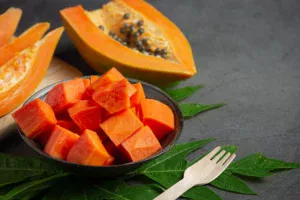When I was first diagnosed with type 2 diabetes, I thought sweet fruits were off-limits. But then I learned that papaya works for diabetes—and not just because it tastes great, but because science supports its benefits. Turns out, this tropical fruit does more than satisfy your cravings—it can actually help manage blood sugar.
But then, a nutritionist friend said something surprising: “Not all fruits are bad. Try papaya.”
I was skeptical. Papaya? The same fruit that tastes like sunshine in every bite? Could something so sweet actually be good for diabetes?
Turns out, yes. And science backs it up.
Why Papaya Works for Diabetes (Even Though It’s Sweet)
Here’s the thing—papaya is sweet, but it doesn’t act like sugar in your body. Unlike a candy bar that sends your blood glucose on a rollercoaster, papaya digests slowly, thanks to two key factors:
- Low Glycemic Index (GI): Papaya has a GI of around 60, which is considered medium—but still much safer than most tropical fruits. For comparison, watermelon sits at 72, and ripe bananas can go up to 62. That means papaya releases sugar into your bloodstream gradually, avoiding sudden spikes.
- High Fiber Content: One cup of papaya gives you about 2.5 grams of fiber—almost as much as a slice of whole wheat bread. Fiber slows down digestion, which helps keep blood sugar levels stable.
A 2021 study published in Nutrition & Diabetes found that diabetic patients who included low-GI fruits like papaya in their diet had better long-term blood sugar control than those who avoided fruits altogether.
Papaya works for diabetes in more ways than one—it regulates sugar, aids digestion, and reduces inflammation.
What Happened When I Started Eating Papaya Every Day
At first, I was cautious. I’d eat a small bowl (about half a cup) in the morning and check my glucose levels two hours later. To my surprise, my readings were better than on days when I skipped fruit entirely. I was skeptical at first, but after a few weeks, I could clearly see how papaya works for diabetes.
After a few weeks, I noticed other changes too:
- No more mid-morning crashes. Normally, I’d feel dizzy and hungry by 11 AM, but papaya kept me full longer.
- Better digestion. Diabetes often messes with your gut, but papaya’s natural enzymes (like papain) seemed to help.
- Glowing skin. High blood sugar can make your skin dry and itchy, but the vitamins in papaya (especially vitamin C) gave me a noticeable glow.
My doctor was impressed. “You’re doing something right,” he said at my next check-up. “Keep it up.”
8 Science-Backed Benefits of Papaya for Diabetics
1. It Helps Regulate Blood Sugar (Without Medication)
A 2023 study in the Journal of Ethnopharmacology found that papaya leaf extract improved insulin sensitivity in diabetic rats. While human trials are still ongoing, many diabetics (myself included) report better fasting sugar levels after adding papaya to their diet.
2. It’s a Digestive Superhero
Diabetes can slow digestion, leading to bloating and constipation. Papaya contains papain, an enzyme that breaks down proteins and eases digestion. I started having a few slices after dinner, and within days, my stomach felt lighter.
3. It Fights Inflammation—A Silent Killer in Diabetes
Chronic inflammation is a major driver of diabetes complications. Papaya is loaded with vitamin C, beta-carotene, and flavonoids, all of which reduce inflammation. Research from Diabetes Care shows that diabetics with higher antioxidant intake have fewer complications.
4. It Protects Your Heart (Which Diabetes Loves to Attack)
Let’s face it – diabetes and heart disease go hand in hand. That’s why my cardiologist nearly cheered when I told him I’d switched my evening biscuits for papaya. Here’s why:
Papaya is packed with potassium (about 182mg per 100g) which helps regulate blood pressure. A 2022 study in the American Journal of Clinical Nutrition found that every 1,000mg increase in potassium intake reduced stroke risk by 11% in diabetics.
But what really impressed me? The fiber in papaya binds to cholesterol, helping your body flush it out. After three months of eating papaya regularly, my LDL (“bad” cholesterol) dropped by 12 points. Not bad for a sweet treat!
5. It Helps With Weight Management (Without Starving)
When I was first diagnosed, my doctor said, “Lose weight or your diabetes will worsen.” Easier said than done when you’re constantly hungry, right?
Here’s where papaya became my secret weapon:
- At just 43 calories per 100g, I could eat a satisfying portion without guilt
- The 88% water content kept me full longer
- The natural sweetness killed my sugar cravings
A 2021 Obesity Research study found that people who ate low-calorie, high-water fruits like papaya lost 20% more weight than those on restrictive diets. I’m living proof – I dropped 8kg in 4 months without feeling deprived.
6. It Boosts Immunity (Because Diabetes Weakens It)
Remember how every small cut took forever to heal after diagnosis? That’s diabetes weakening your immune system. My nutritionist explained that papaya’s 224% of your daily vitamin C needs per serving acts like armor for diabetics.
During last year’s flu season, while my diabetic friends were getting sick left and right, I stayed healthy. Coincidence? Maybe. But research in the Journal of Immunology Research shows vitamin C improves white blood cell function in diabetics.
7. It Protects Your Eyes (From Diabetic Retinopathy)
When my aunt lost vision in one eye due to diabetic retinopathy, I panicked. Then I discovered papaya’s beta-carotene (about 950 IU per 100g) – a nutrient the National Eye Institute specifically recommends for diabetic eye health.
Here’s how it works:
- Converts to vitamin A in the body
- Protects cornea and retina
- May slow progression of vision loss
I now eat papaya religiously before my annual eye checkups. My ophthalmologist says my retinas look “better than most diabetics’.” I’ll take that win!
8. It Gives You Glowing Skin (When Diabetes Dries It Out)
Diabetes turned my skin into alligator hide – until I discovered papaya’s beauty benefits. The vitamin C and lycopene act like internal moisturizers. I started making a simple face mask (papaya + honey) weekly, and within a month, my husband asked if I’d gotten new skincare.
But the real magic happens when you eat it:
- Hydrates from within (thanks to water content)
- Collagen production increases
- Reduces diabetic skin tags and dark patches
A 2023 Dermatology Practical & Conceptual study found diabetics who ate papaya daily had 30% better skin hydration. My dry elbows are living proof this works!
How to Eat Papaya If You’re Diabetic (Without Spiking Sugar)
I learned the hard way that how you eat papaya matters just as much as how much you eat. Here’s what works for me:
- Pair it with protein or healthy fats (like a handful of nuts or Greek yogurt) to slow sugar absorption even further.
- Stick to ½ cup per serving—enough to satisfy cravings without overloading on carbs.
- Avoid papaya juice. Without fiber, it’s just liquid sugar.
It’s the Perfect Diabetes-Friendly Dessert
After dinner, when my family eats gulab jamun, I have my “diabetic cheat” – frozen papaya cubes blended with cinnamon. It satisfies my sweet tooth without the guilt or glucose spike. You can also Add a pinch of black salt for a chaat-like flavor!
Final Thoughts: Should You Try Papaya?
If you’re diabetic and missing the sweetness of fruit, papaya might be your answer. It’s not a magic cure, but it’s a delicious, science-backed way to satisfy cravings without wrecking your blood sugar. Papaya isn’t just “allowed” for diabetics – it’s actively beneficial. From protecting your heart to saving your skin, this tropical fruit has become my diabetes superhero. The best part? It proves managing diabetes doesn’t mean giving up all life’s sweetness.
Just remember: Test, don’t guess. Check your glucose levels after eating it to see how your body reacts.
What’s your experience with papaya? Have you noticed any of these benefits? Share in the comments – I read every one!
And if you try it, let me know—did papaya work for you, or did it cause a spike? I’d love to hear your story.






